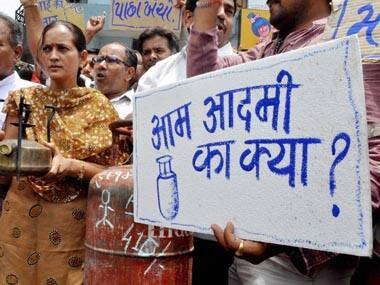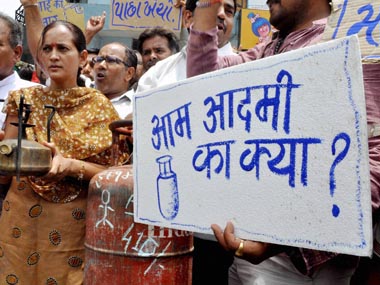“The solution cannot simply be massive debt monetisation by the ECB (European Central Bank). The solution must include credible, verifiable, and ’enforceable’ fiscal consolidation in various countries. Only then can the ECB agree to act as a bridge until the day that fiscal consolidation is implemented and is successful”.
The Reserve Bank of India (RBI) should use this statement made by the ECB, which is saying that it is ready to act as the lender of last resort but only on the condition that governments show credible fiscal consolidation. The RBI has been consistently warning the government on its fiscal profligacy, as it impedes the process of monetary transmission.
However, despite warnings the government has steadfastly refused to implement any kind of reforms on food, fuel, fertiliser and power subsidies as well as making no progress in improving the tax-to-GDP ratio.
[caption id=“attachment_149236” align=“alignleft” width=“380” caption=“People shout slogans against UPA government during a protest against hike on fuel and LPG prices in Ahmedabad. PTI”]
 [/caption]
[/caption]
The result of lack of reforms on subsidies and taxes is telling on government finances. The government is set to fall short of its fiscal deficit target of 4.6 percent of GDP for 2011-12 by at least 1 percent and this will take the deficit to 5.6 percent - higher than the 5.1 percent deficit seen in 2010-11.
The states’ fiscal position is also getting into a mess with expected losses of Rs 100,000 crore of SEBs (State Electricity Boards) having to be borne by state governments. State-level fiscal deficit will exceed the 2.2 percent of GDP projected for 2011-12 if the SEB losses are taken into consideration.
India’s total debt-to-GDP ratio, at 65 percent (centre and states), is not anywhere close to the levels of deeply-troubled nations of Italy, Greece, Ireland and Portugal where debt to GDP ratios are higher than 115 percent. However, this figure excludes the liabilities that the centre may have taken on for underfunded oil subsidies and the losses of SEBs that states have to provide for. The real debt-GDP ratio figure probably exceeds 70 percent and may be rising.
What is clear is that the government cannot stand up and say India has done a good job in managing its deficit. In fact, the central government’s fiscal position has deteriorated considerably from levels of 2.55 percent of GDP in 2007-08 to current expected levels of 5.6 percent of GDP in 2011-12. State government finances were in surplus until 2008-09 and it has now gone back into a minor deficit.
The government has done nothing to usher in much needed reforms to keep its deficits under control. Subsidies as a percentage of GDP have gone up from 1.3 percent levels in 2006-07 to 2.08 percent levels in 2010-11. The rise of over 30 percent in oil prices on a year-on-year basis as of end November 2011 is likely to take up the subsidy bill for 2011-12 to levels higher than 2.08 percent as there has been no pass-through of rising fuel prices to the end user.
Gross tax-to-GDP ratio has remained in a 9-10 percent range over the last 10 years and the government became myopic on tax reforms as tax collections improved due to GDP growth trending at 8.9 percent levels in the 2003-04 to 2007-08 period. The expected fall in growth rates for 2011-12 to 7.6 percent from the 8.6 percent levels seen in 2010-11 will suddenly make the lack of growth in tax-GDP ratio stand out. Lower tax revenues in the face of a rising subsidy bills will turn government finances haywire.
The government is already facing the heat on its lack of fiscal consolidation. Bond yields had shot up by 60 basis points (100 bpx make 1 percent) on the back of the government announcing a higher than expected borrowing programme for the second half of 2011-12. Ten-year benchmark bond yields touched multi-year highs of 9 percent as markets fretted over bond supply.
The RBI had to step in to buy government bonds in order to stabilise yields. Bond yields have since come off from 9 percent levels to 8.65 percent on the back of RBI bond purchases.
But the RBI cannot be buying government bonds indefinitely. Its measures can only have temporary effect and, for a more permanent effect on lower interest rates, the government has to urgently usher in reforms on the expenditure and revenue front.
Eurozone countries have realised the fickle nature of markets. When the going is good, markets fall over themselves to give money but when it gets bad, markets pull down economies.
India still has time to get its act in order. The hope is that the government wakes up to fiscal consolidation and if this can be achieved, the country will not look back.
Arjun Parthasarathy is the Editor of www.investorsareidiots.com , a web site for investors.
Arjun Parthasarathy has spent 20 years in the financial markets, having worked with Indian and multinational organisations. His last job was as head of fixed income at a mutual fund. An MBA from the University of Hull, he has managed portfolios independently and is currently the editor of www.investorsareidiots.com </a>. The website is for investors who want to invest in the right financial products at the right time.
)